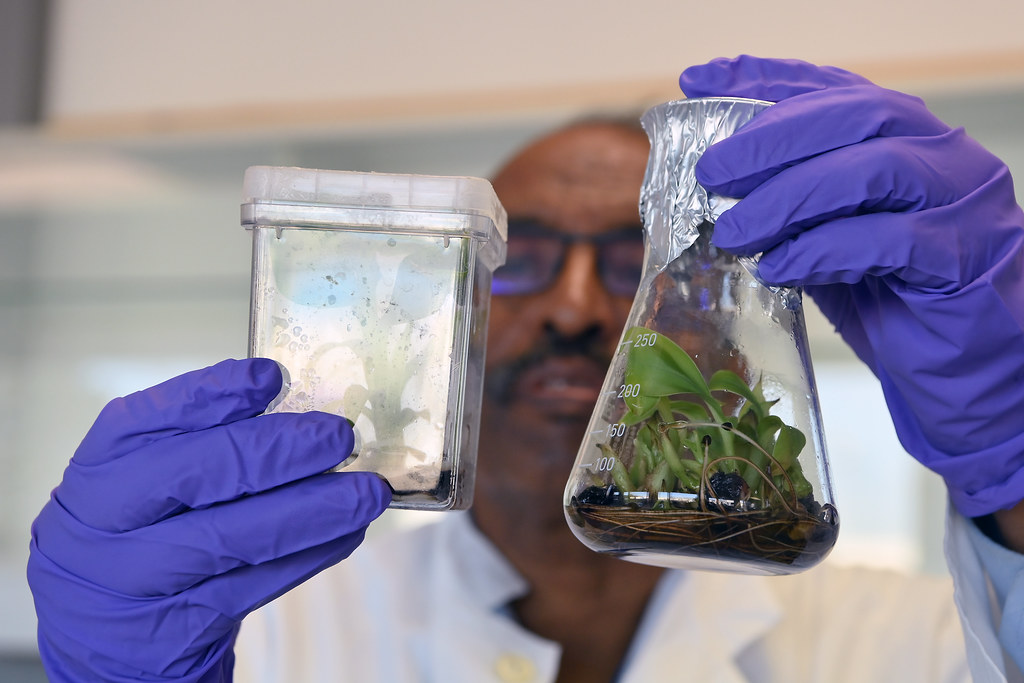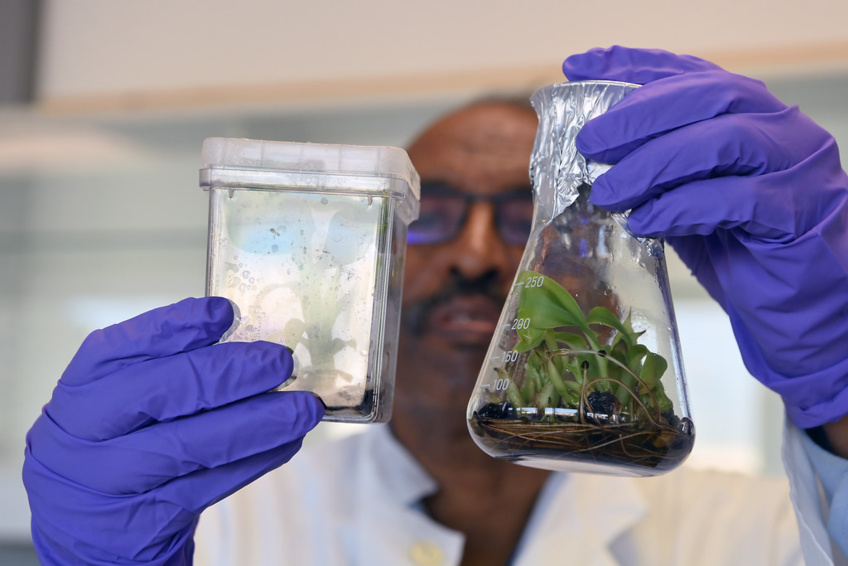Long before our era, the first plant “breeders”, often by chance, were drawn to plants that satisfied their needs for sustenance and clothing. Safety was simply determined by trial and error: “that made me ill” or “this is delicious – I’ll have it again!”
Fast forward to Gregor Mendel, who brought about a revolution in our understanding of inheritance and genetics. Nowadays, breeders employ sophisticated methods to select high-performing plants for food, feed, and fiber products that are valuable to us as consumers and farmers. As a child growing up on a farm in Uttar Pradesh, India’s ‘potato belt’, I experienced the delight of a bountiful harvest of potatoes, mustard, and wheat, as well as the disappointment of losing a cotton crop to the pink bollworm.
Protecting our cotton from this destructive pest was crucial for my family, and thanks to scientific advancements (and human ingenuity), we now have incredible solutions for farmers and agriculture!
But how can we be sure these plants are safe to consume or cultivate?
In addition to selective breeding practices, plant breeders also incorporate safety evaluations at every stage to ensure they don’t introduce anything harmful into the plants they’re developing—or the environment where they’ll grow. Breeders use their knowledge and skills to combine desirable traits like size, shape, texture, color, and disease resistance into a plant variety. The entire breeding process can take years and varies depending on the plant. For example, it takes about 10 years to develop and commercialize a new maize variety and up to 25 years for apples. These methods, honed over centuries, allow breeders to transfer and combine only intended traits into the plant variety and exclude undesirable ones.
A significant aspect of my role at Bayer Crop Science is addressing these safety concerns, and we have an abundance of data supporting the safety of our breeding portfolio. I recently co-authored a peer-reviewed scientific paper in which we examined strategies used by plant breeders to ensure the safety of foods from selective breeding. We discovered that:
…there were no documented instances where conventional breeding practices resulted in the production of new toxins or toxins not associated with the given crop. This is because selective breeding rearranges the genes from the parent plants but does not create new genes for producing new toxins, opined Shilpa Swarup, a geneticist.
In other words, modern plant breeders use current tools and traditional techniques to continually develop crops that are as safe—if not safer—than those in the past.
The following are the integral safety evaluations conducted during the breeding development process to ensure the safety of new plant varieties:
Backcrossing This technique involves strategic cross-breeding between plants. The purpose of backcrossing is to transfer one or a few desirable genes from one plant to another that already has many favorable characteristics. This process is crucial for developing a new plant with only the desired gene incorporated. For instance, a wild-type tomato might have a disease-resistant gene of interest, but it may also have an undesirable trait, such as small size.
Utilization of Elite Seed The backcrossing method is used to transfer the desired gene into a group of elite lines, a process known as germplasm. These elite plants are well characterized, adapted to specific environments and geographies, high-performing, and have been commercially used for decades with a ‘history of safe’ use. The use of elite germplasm eliminates the chance of incorporating a new, random, or novel gene.
Field Testing Breeders cross-pollinate elite plants in various combinations, resulting in hundreds of progenies. These progenies are potential varieties that undergo rigorous field-testing over multiple years at multiple locations. The main concern regarding crop safety is the possibility of a new and/or random toxin in any variety. Therefore, breeders use stringent selection criteria specific to each crop to eliminate potential unintended effects.
For example, apple seeds contain cyanide toxin, but since we typically consume the apple’s skin and flesh and not the seeds, apple breeders focus on improving attributes such as texture, color, taste, and size of the flesh and skin. Conversely, potato breeders know that potatoes naturally produce a toxin called glycoalkaloids, which must be kept below a certain threshold required by global regulatory agencies. Therefore, they monitor and quantify potato glycoalkaloid levels along with other quality parameters.
These steps combined ensure that the resulting varieties do not have any unwanted (from backcrossing), random (from germplasm), or unintended (from field testing) effects.
Regulatory bodies worldwide ensure that seed developers are responsible for the safety of all new plant varieties, from the field to the market. This applies irrespective of the tools, techniques, and technologies used in their development.
Furthermore, general food safety principles are acknowledged and incorporated into national food laws globally. Our worldwide food supply adheres to the highest safety standards. This, along with generations of historical knowledge and safe consumption, modern selective breeding techniques, and a robust set of industry standards and government oversight, guarantees the safety of new crop varieties introduced to the market.
My gratitude goes out to Mendel for his groundbreaking discoveries in plant genetics. I have personally witnessed the advantages that quality seed technology brought to our farm in India. This farm inspired me to embark on a career in science and agriculture. It led me to become a geneticist. It made me a firm believer in plant breeding technologies. I hope this blog encourages others to learn more about how we cultivate safe and nutritious seeds to provide food for our tables!
Fast forward to Gregor Mendel, who brought about a revolution in our understanding of inheritance and genetics. Nowadays, breeders employ sophisticated methods to select high-performing plants for food, feed, and fiber products that are valuable to us as consumers and farmers. As a child growing up on a farm in Uttar Pradesh, India’s ‘potato belt’, I experienced the delight of a bountiful harvest of potatoes, mustard, and wheat, as well as the disappointment of losing a cotton crop to the pink bollworm.
Protecting our cotton from this destructive pest was crucial for my family, and thanks to scientific advancements (and human ingenuity), we now have incredible solutions for farmers and agriculture!
But how can we be sure these plants are safe to consume or cultivate?
In addition to selective breeding practices, plant breeders also incorporate safety evaluations at every stage to ensure they don’t introduce anything harmful into the plants they’re developing—or the environment where they’ll grow. Breeders use their knowledge and skills to combine desirable traits like size, shape, texture, color, and disease resistance into a plant variety. The entire breeding process can take years and varies depending on the plant. For example, it takes about 10 years to develop and commercialize a new maize variety and up to 25 years for apples. These methods, honed over centuries, allow breeders to transfer and combine only intended traits into the plant variety and exclude undesirable ones.
A significant aspect of my role at Bayer Crop Science is addressing these safety concerns, and we have an abundance of data supporting the safety of our breeding portfolio. I recently co-authored a peer-reviewed scientific paper in which we examined strategies used by plant breeders to ensure the safety of foods from selective breeding. We discovered that:
…there were no documented instances where conventional breeding practices resulted in the production of new toxins or toxins not associated with the given crop. This is because selective breeding rearranges the genes from the parent plants but does not create new genes for producing new toxins, opined Shilpa Swarup, a geneticist.
In other words, modern plant breeders use current tools and traditional techniques to continually develop crops that are as safe—if not safer—than those in the past.
The following are the integral safety evaluations conducted during the breeding development process to ensure the safety of new plant varieties:
Backcrossing This technique involves strategic cross-breeding between plants. The purpose of backcrossing is to transfer one or a few desirable genes from one plant to another that already has many favorable characteristics. This process is crucial for developing a new plant with only the desired gene incorporated. For instance, a wild-type tomato might have a disease-resistant gene of interest, but it may also have an undesirable trait, such as small size.
Utilization of Elite Seed The backcrossing method is used to transfer the desired gene into a group of elite lines, a process known as germplasm. These elite plants are well characterized, adapted to specific environments and geographies, high-performing, and have been commercially used for decades with a ‘history of safe’ use. The use of elite germplasm eliminates the chance of incorporating a new, random, or novel gene.
Field Testing Breeders cross-pollinate elite plants in various combinations, resulting in hundreds of progenies. These progenies are potential varieties that undergo rigorous field-testing over multiple years at multiple locations. The main concern regarding crop safety is the possibility of a new and/or random toxin in any variety. Therefore, breeders use stringent selection criteria specific to each crop to eliminate potential unintended effects.
For example, apple seeds contain cyanide toxin, but since we typically consume the apple’s skin and flesh and not the seeds, apple breeders focus on improving attributes such as texture, color, taste, and size of the flesh and skin. Conversely, potato breeders know that potatoes naturally produce a toxin called glycoalkaloids, which must be kept below a certain threshold required by global regulatory agencies. Therefore, they monitor and quantify potato glycoalkaloid levels along with other quality parameters.
These steps combined ensure that the resulting varieties do not have any unwanted (from backcrossing), random (from germplasm), or unintended (from field testing) effects.
Regulatory bodies worldwide ensure that seed developers are responsible for the safety of all new plant varieties, from the field to the market. This applies irrespective of the tools, techniques, and technologies used in their development.
Furthermore, general food safety principles are acknowledged and incorporated into national food laws globally. Our worldwide food supply adheres to the highest safety standards. This, along with generations of historical knowledge and safe consumption, modern selective breeding techniques, and a robust set of industry standards and government oversight, guarantees the safety of new crop varieties introduced to the market.
My gratitude goes out to Mendel for his groundbreaking discoveries in plant genetics. I have personally witnessed the advantages that quality seed technology brought to our farm in India. This farm inspired me to embark on a career in science and agriculture. It led me to become a geneticist. It made me a firm believer in plant breeding technologies. I hope this blog encourages others to learn more about how we cultivate safe and nutritious seeds to provide food for our tables!


 Ensuring Crop Safety: The Role of Regulations and Plant Breeding Technologies
Ensuring Crop Safety: The Role of Regulations and Plant Breeding Technologies





 Companies
Companies